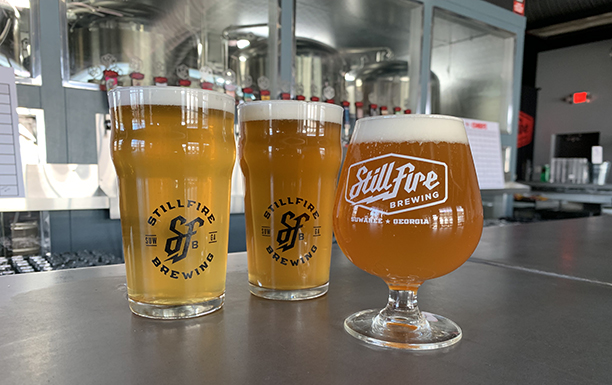When you think of world-renowned cooks, we imagine that The Swedish Chef (“Bork, bork, bork!”) comes to mind long before Dr. Bunsen Honeydew and Beaker (“Meep!”). But the process of cooking and baking is nothing if not applied science. Molecular gastronomy, the scientific discipline concerned with the physical and chemical transformations that occur during cooking, is an art form involving biology, chemistry, mechanics, and physics – talk about S.T.E.A.M.!
It’s more than a matter of taste: science tells us why we fold batter (instead of stir) for chewy brownies, why you whip egg whites with sugar, and why the addition of salt makes meat juicier. The proof is in the recipe: specific ingredients, measurements, and instructions, all designed to lead to a specific, repeatable outcome. Cooking may be an art, but while good art may be subjective, the objective nature of science makes great cooking is easier to grasp and repeat. Food for thought, indeed.

Beer only has four main ingredients: water, malted grains, hops, and yeast. But the combinations and processes contribute to the type of beer, flavor, and how it is alcoholic. With so few ingredients, the quality of each can make a huge difference. Calcium and magnesium in water affect how the yeast grows and metabolize sugars; bicarbonate affects the pH during the fermentation process. Hops acts as a surfactant that allows bubbles to be trapped in the head of a beer; without hops, there is not enough surface tension or stabilization, resulting in no head and a bitter taste. And finally…
“We care and nurture our little single-celled partners, brewer’s yeast. Without our little buddies, we would be serving a sweet barley soup devoid of alcohol,” said Phil Farrell, StillFire Brewing’s award-winning brewmaster. “Yeast does the heavy lifting during fermentation, producing the alcohol levels you expect in beer while adding a unique character that is different for every yeast strain. We have to be careful to pair the appropriate yeast to the target beer style, because every yeast is different. Brewers must ensure the yeast is well fed and has a clean environment, but other than controlling temperature, the process is out of our hands once yeast gets involved.” Raise a glass to years and years and years of zymology (the science of fermentation and the action of enzymes) on National Beer Day on April 7.
SAY CHEESE!
It’s really not normal to think of the delicious cheese when you think of your favorite steakhouse – and that is in no way a knock to the delicious steaks that diners, true the name, leave as a pile of bare bones.
Understandably, Bare Bones Steakhouse owners Buddy and Gaye Maughon take pride in their great cuts of meat (it helps that Buddy is a Master Meat Cutter and veteran butcher). But another point of pride is that literally everything except the ketchup is house-made.“The kitchen is adamant that everything is made from scratch,” said Gaye. “Only the bread and cheesecake aren’t made in-house.”
This includes Bare Bones Steakhouse homemade mozzarella, found in their Caprese salad, or steak a la Caprese (both of which we highly recommend). The cheese making process always begins with milk, but the animal that the milk comes from can make all the difference. Mammals obviously make milk to feed their young, and the needs of a baby cow versus a baby goat versus a baby moose vary – so the concentrations of water, proteins, lactose, and fat vary as well. To make cheese, the conditions of the milk must change to facilitate a chemical reaction, which results in milk separating into Little Miss Muffet’s favorite parts: curds and whey.
In dairy milk, casein the protein that coagulates around lactose and fat and solidifies to form the cheese curds. Acidic lemon juice is then added to lower the pH of the milk and alter the negatively charged casein, causing coagulation, when lactose and fats are captured to create curds. The addition of more lemon juice creates rennet, which is an enzyme that helps the curds firm up into the delicious fresh mozzarella that has some of us going to a steakhouse for an entirely different cow byproduct.
TOUT EST POSSIBLE
What do the climates of France and Georgia have in common? Absolutely nothing. But that hasn’t stopped Lan and Jack Cheng from creating the most beautiful – and technically difficult – French pastry in her Duluth Mac Lab bakery. The Chengs attended the Culinary Institute of America in Hyde Park, NY, then confidently after her graduation, Lan returned home, only to find that Atlanta’s famous humidity did not agree with macaron baking. Lan spent a year experimenting with recipes and testing macarons that worked in high humidity – and that’s not even considering the sunny versus rainy days, ingredient moisture content of each ingredient, and barometric pressure. (Hence the name, Mac Lab.) “They are sensitive and very high-maintenance, but so darn cute,” laughs Cheng. While temperature is also a factor, macarons are incredibly sensitive to moisture above all. Some recipes call for “aging egg whites,” as when egg whites get old they lose some moisture; some recommend powdered food color to control the water content in the batter. In our southern climate, air conditioning is recommended year-round for drying out the air (and the baker). Making the perfect macaron is equal parts creativity and technical skill.
